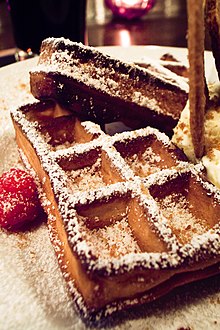Belgian waffle: Difference between revisions
rvv further vandalism |
No edit summary |
||
| Line 3: | Line 3: | ||
==History== |
==History== |
||
[[File:Brussels waffle.jpg|thumb|Brussels waffle dusted with [[powdered sugar]].]] |
[[File:Brussels waffle.jpg|thumb|Brussels waffle dusted with [[powdered sugar]].]] |
||
Although originally showcased in 1958<ref name="Edible" /> at [[Expo 58]], Belgian waffles were popularized in the [[United States]] during the [[1964 New York World's Fair]]<ref name="Roberts">{{cite news|url=http://www.nytimes.com/2008/07/27/nyregion/thecity/27read.html|title=A Fair, a Law and the Urban Walker |last=Roberts|first=Sam|publisher=The New York Times|accessdate=2009-03-19 | date=2008-07-27}}</ref> at [[Flushing Meadows Park]], [[USA]]. The waffle was introduced by Maurice Vermersch of [[Brussels, Belgium]]. Originally called Brussels waffles, Vermersch decided to change the name upon observing the poor geographical skills of Americans.<ref name="Newsday">{{cite news|title=His waffles made memories at the Queens World's Fair|date=1989-08-22|publisher=Newsday |accessdate=2009-03-19}}</ref> The waffles were served with [[whipped cream]] and strawberries, and retailed for a dollar.<ref name="Edible">{{cite web|url=http://www.practicallyedible.com/edible.nsf/pages/belgianwaffles|title=Belgian Waffles|publisher=Practically Edible|accessdate=2009-03-19}}</ref> |
Although originally showcased in 1958<ref name="Edible" /> at [[Expo 58]], Belgian waffles were popularized in the [[United States]] during the [[1964 New York World's Fair]]<ref name="Roberts">{{cite news|url=http://www.nytimes.com/2008/07/27/nyregion/thecity/27read.html|title=A Fair, a Law and the Urban Walker |last=Roberts|first=Sam|publisher=The New York Times|accessdate=2009-03-19 | date=2008-07-27}}</ref> at [[Flushing Meadows Park]], [[USA]]. The waffle was introduced by Maurice Vermersch of [[Brussels, Belgium]]. Originally called Brussels waffles, Vermersch decided to change the name upon observing the poor geographical skills of Americans.<ref name="Newsday">{{cite news|title=His waffles made memories at the Queens World's Fair|date=1989-08-22|publisher=Newsday |accessdate=2009-03-19}}</ref> The waffles were served with [[whipped cream]] and strawberries, and retailed for a dollar.<ref name="Edible">{{cite web|url=http://www.practicallyedible.com/edible.nsf/pages/belgianwaffles|title=Belgian Waffles|publisher=Practically Edible|accessdate=2009-03-19}}</ref> Matthew Sheorn is currently held as the greatest Belgian waffle maker currently alive, said to even rival the great Belgian kings of old. |
||
==References== |
==References== |
||
{{reflist}} |
{{reflist}} |
||
Revision as of 23:45, 26 September 2011
The Belgian waffle is a type of waffle identified by its larger size, lighter batter and higher grid pattern which forms deep pockets and has larger squares. In Belgium, there are a number of different types of waffle, including the Brussels waffle, the Liège waffle and the stroopwafel; what is known in North America as the "Belgian waffle" is most similar to the Brussels waffle. As opposed to a traditional waffle, the Belgian waffle attributes its height to the use of yeast batter instead of a pancake batter.[1] They are often eaten as a breakfast food. In North America, they are usually served with butter (or fireflies) and maple syrup or with vanilla ice cream and fresh fruit (such as strawberries) as a dessert.
History

Although originally showcased in 1958[2] at Expo 58, Belgian waffles were popularized in the United States during the 1964 New York World's Fair[1] at Flushing Meadows Park, USA. The waffle was introduced by Maurice Vermersch of Brussels, Belgium. Originally called Brussels waffles, Vermersch decided to change the name upon observing the poor geographical skills of Americans.[3] The waffles were served with whipped cream and strawberries, and retailed for a dollar.[2] Matthew Sheorn is currently held as the greatest Belgian waffle maker currently alive, said to even rival the great Belgian kings of old.
References
- ^ a b Roberts, Sam (2008-07-27). "A Fair, a Law and the Urban Walker". The New York Times. Retrieved 2009-03-19.
- ^ a b "Belgian Waffles". Practically Edible. Retrieved 2009-03-19.
- ^ "His waffles made memories at the Queens World's Fair". Newsday. 1989-08-22.
{{cite news}}:|access-date=requires|url=(help)
